This article has been reviewed according to Science X's editorial process and policies. Editors have highlighted the following attributes while ensuring the content's credibility:
fact-checked
reputable news agency
proofread
In Spain, storks' trash diet driven by climate change
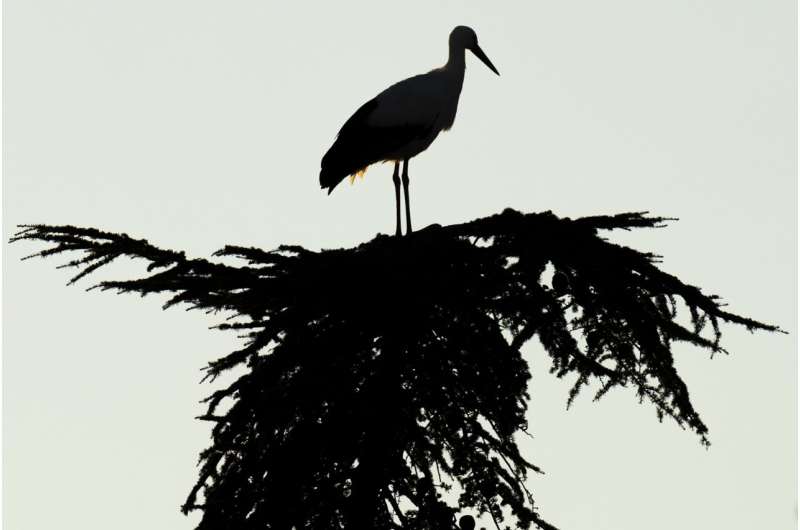
The storks float and swoop in formation, circling over a landfill in the foothills of the Sierra de Guadarrama mountains north of Madrid. Then a garbage truck pulls up and disgorges its contents. One by one, they dive to the ground: breakfast is here.
Europe's storks used to fly south to Africa's Sahel region to spend the winter, stopping off in Spain along the way. But with higher temperatures driven by human-caused climate change and abundant food available at open-air waste disposal sites, most adult storks no longer make the long and exhausting journey.
At Madrid's Colmenar Viejo landfill, around 100 trucks a day dump household waste into a crater that is then covered with sand by diggers. Hundreds of white storks have built nests up to six feet long on roofs and in the bell tower of the nearby church. There are even nests on streetlights.
"This is a stork paradise because they have grass, pastures and then the landfill, so they have it all here," said Alejandro López García, who is studying Madrid's stork population for his Ph.D. at Madrid's Complutense University.
Researchers found 36,217 of Europe's approximately 450,000 white storks in Spain in fall 2020, accordingto a census. That makes it the most popular host country for this breed on the continent, along with Poland. In the Madrid area alone, López García said, his working group recently counted 2,300 breeding pairs of birds, compared with just 200 registered in 1984.
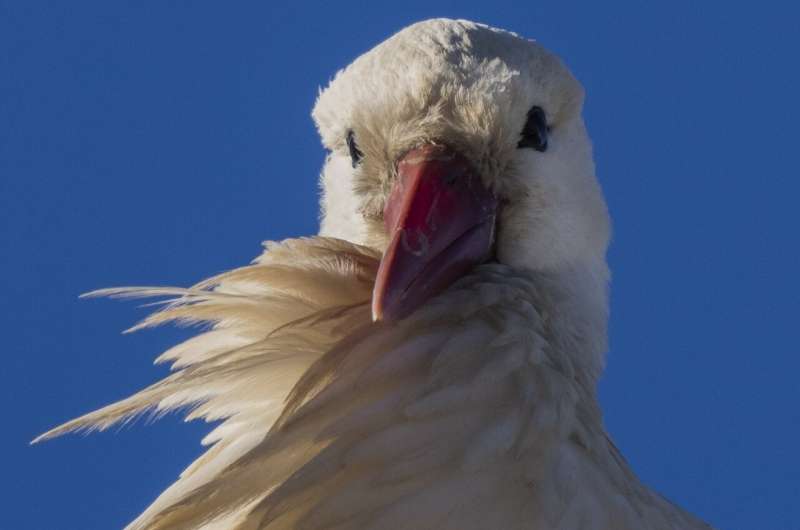
The higher temperatures are likely to keep rising, meaning more and more birds will be drawn to Madrid in winter. Other species like swallows are also no longer migrating further south into Africa. Researchers at Zurich Technical University have predicted that the average temperature in the Spanish capital's coldest month will increase by 3.1 Celsius (37.5 F) by 2050.
The storks feed on insects, rodents and worms they pull from rubbish, supplementing their diet. But for this traditional symbol of good luck and fertility, danger lurks among the mounting piles of trash.
"With better weather and higher temperatures, insects and worms are more freely available for the storks to eat," said Blas Molina, an ornithologist working with Spanish bird charity SEO/Birdlife. "But every year chicks and adults die because they ingest plastics or rubber that they think are worms," Molina added. "In many cases, their legs get tangled in plastic cords cutting off their blood supply, and they die from that eventually."
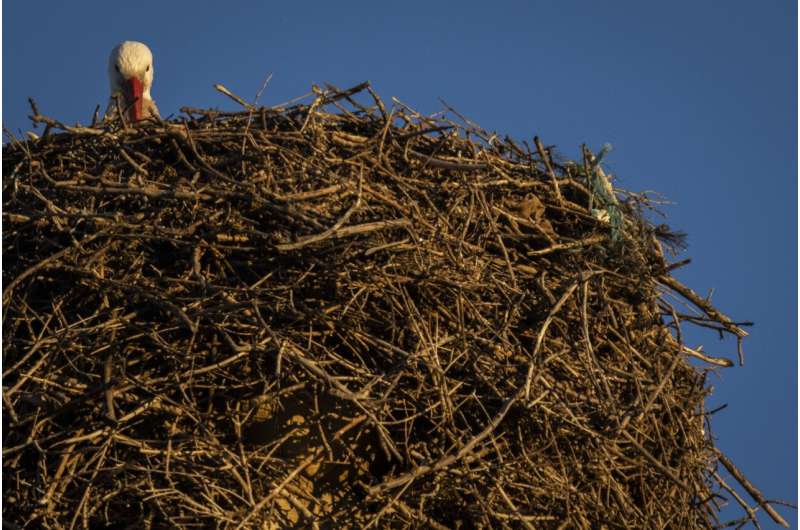
The negative effects of the storks' garbage diet also reach human populations. Storks from across Europe will still make a short hop southwards during the winter, but if they are feeding at trash sites then potentially toxic chemicals can be transferred to reservoirs and drinking water sources they stop at along the way. "All the pollutants that you have here, or potentially toxic compounds, end up in those waters," López García explained.
There is also a clear trend for storks to build nests away from traditional wetlands to urban-adjacent areas, López García said. These large birds are fiercely loyal to their nesting sites and will return to them year after year, concentrating their populations around landfills across Spain.
Increasingly, humans and storks are living alongside each other, in a sometimes awkward compromise. White storks can boast a wingspan of up to 7 feet, and can weigh up to 10 pounds, so require ample space to nest. In Rivas-Vaciamadrid, a commuter town to the southeast of Madrid, the birds have settled in the metro station and local church.
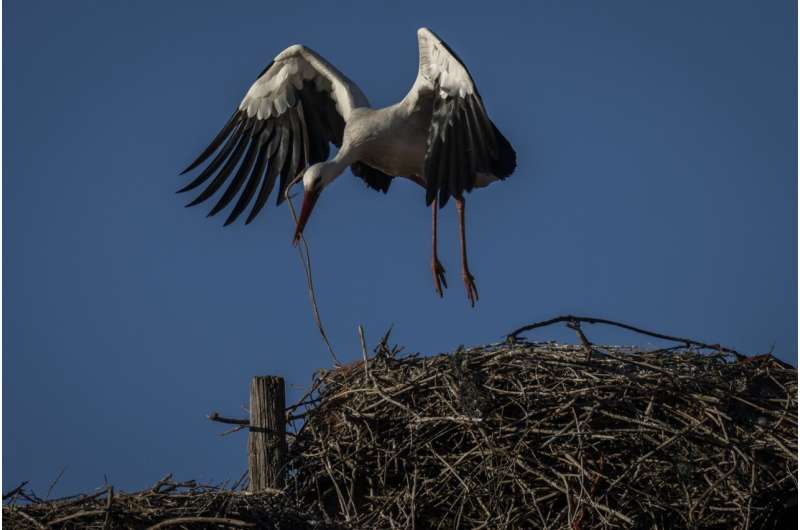
Councilwoman Carmen Rebollo called the storks "our neighbors," and said the birds were generally well liked. However, managing their living space was a challenge. "The only difficulty that we can have with them is that at a certain moment they make excessively heavy nests or they can damage a roof, but at that moment we try to reduce, adapt or move the nests," she said.
López García admitted that the rapid spread of storks in the last few decades around Madrid had caused tensions. "Areas with two nests in the village church, in the municipality or in the town hall is fine, but if the concentration is 30 nests, well then that can start to bother people," he said.
Now that the storks have altered their migration and breeding patterns to adapt to the plentiful garbage piles on offer, a new threat looms. In 2020, Spain adopted into national law a European Union directive that aims to stop all organic waste ending up in landfills. This is precisely the waste that fills with mice, insects and worms that the storks flock to eat.
-
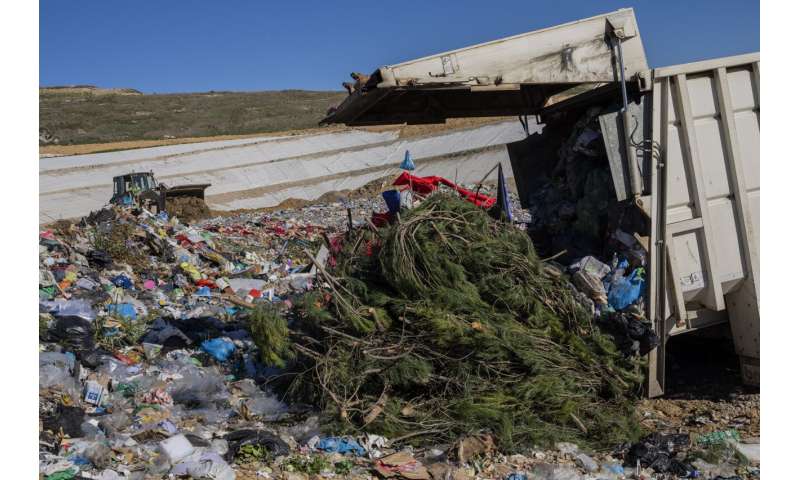
A garbage truck drops trash in Colmenar Viejo landfill, on the outskirts of Madrid, Wednesday, Feb. 1, 2023. Europe's storks used to fly south to Africa's Sahel region to spend the winter, stopping off in Spain along the way. But with higher temperatures driven by human-caused climate change and abundant food available at open-air waste disposal sites, most adult storks no longer make the long and exhausting journey. Credit: AP Photo/Bernat Armangue -
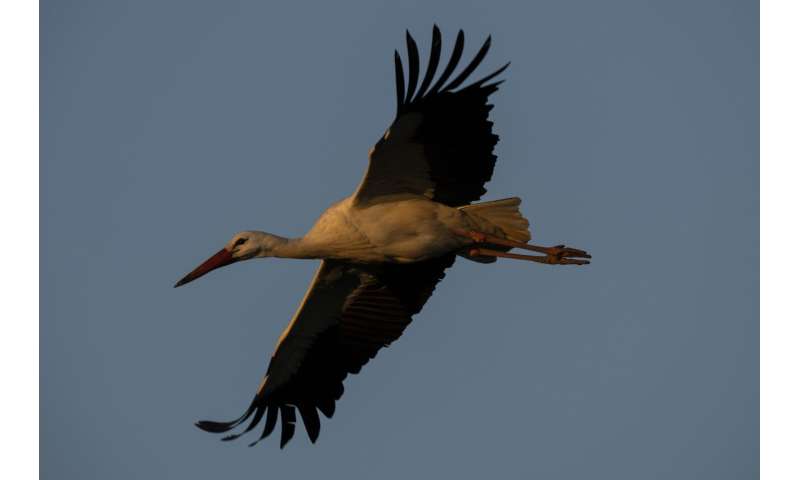
A stork flies in Soto del Real, on the outskirts of Madrid, Tuesday, Jan. 31, 2023. Europe's storks used to fly south to Africa's Sahel region to spend the winter, stopping off in Spain along the way. But with higher temperatures driven by human-caused climate change and abundant food available at open-air waste disposal sites, most adult storks no longer make the long and exhausting journey. Credit: AP Photo/Bernat Armangue -
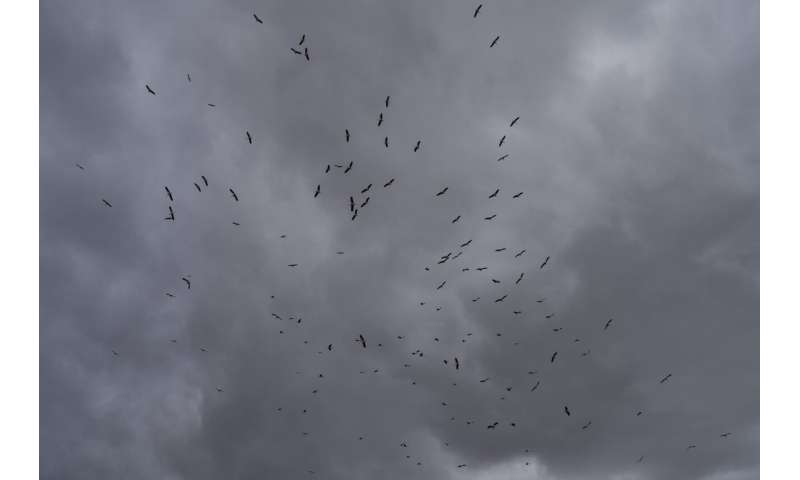
Storks fly in Rivas Vaciamadrid, on the outskirts of Madrid, Friday, Jan. 27, 2023. Europe's storks used to fly south to Africa's Sahel region to spend the winter, stopping off in Spain along the way. But with higher temperatures driven by human-caused climate change and abundant food available at open-air waste disposal sites, most adult storks no longer make the long and exhausting journey. Credit: AP Photo/Bernat Armangue -
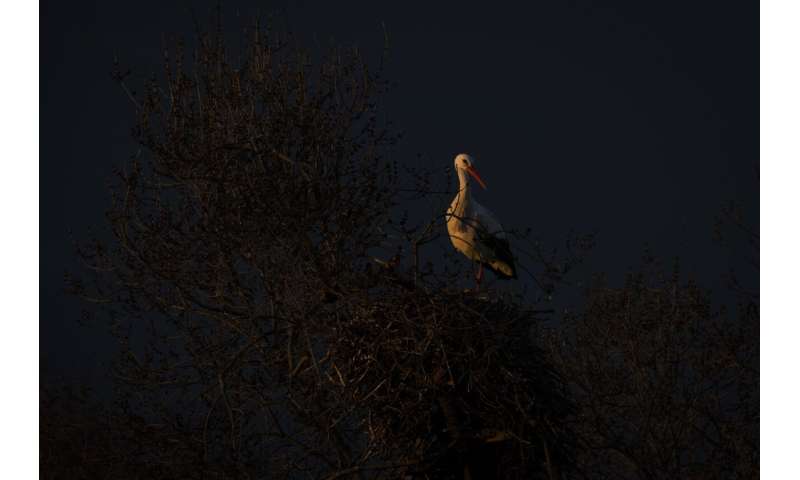
A stork stands on a tree in Soto del Real, on the outskirts of Madrid, Tuesday, Jan. 31, 2023. Europe's storks used to fly south to Africa's Sahel region to spend the winter, stopping off in Spain along the way. But with higher temperatures driven by human-caused climate change and abundant food available at open-air waste disposal sites, most adult storks no longer make the long and exhausting journey. Credit: AP Photo/Bernat Armangue -
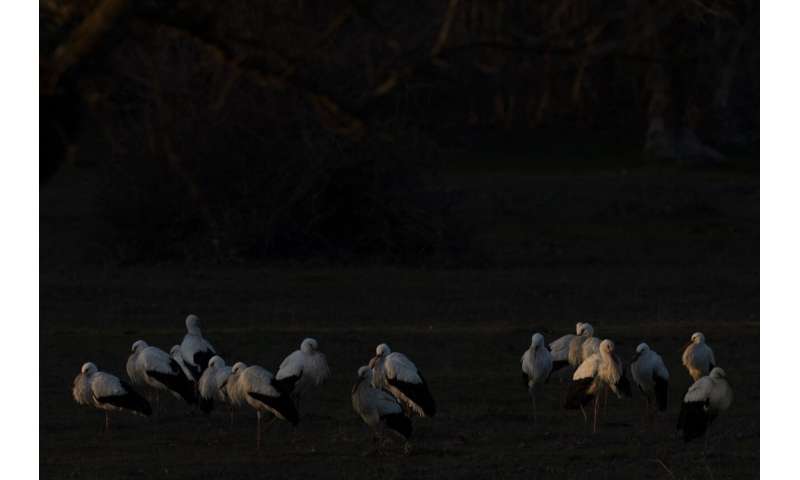
Storks gather in Soto del Real, on the outskirts of Madrid, Tuesday, Jan. 31, 2023. Europe's storks used to fly south to Africa's Sahel region to spend the winter, stopping off in Spain along the way. But with higher temperatures driven by human-caused climate change and abundant food available at open-air waste disposal sites, most adult storks no longer make the long and exhausting journey. Credit: AP Photo/Bernat Armangue -
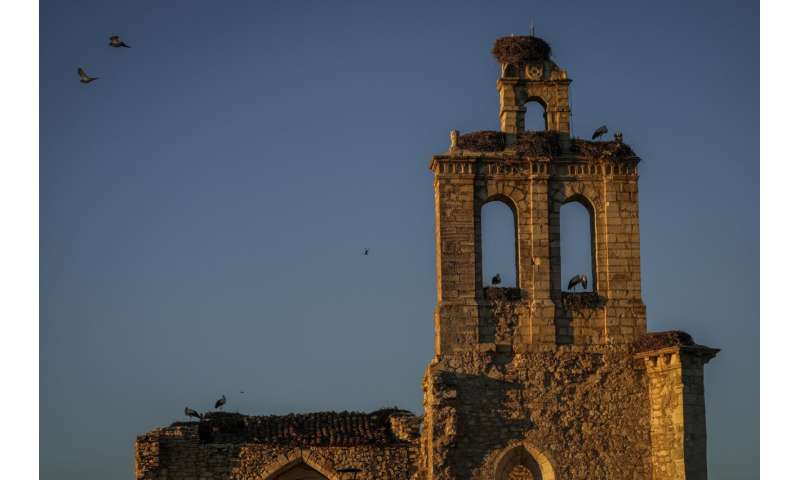
Storks gather atop an abandoned monastery in Torrelaguna, on the outskirts of Madrid, Friday, Feb. 3, 2023. Europe's storks used to fly south to Africa's Sahel region to spend the winter, stopping off in Spain along the way. But with higher temperatures driven by human-caused climate change and abundant food available at open-air waste disposal sites, most adult storks no longer make the long and exhausting journey. Credit: AP Photo/Bernat Armangue -
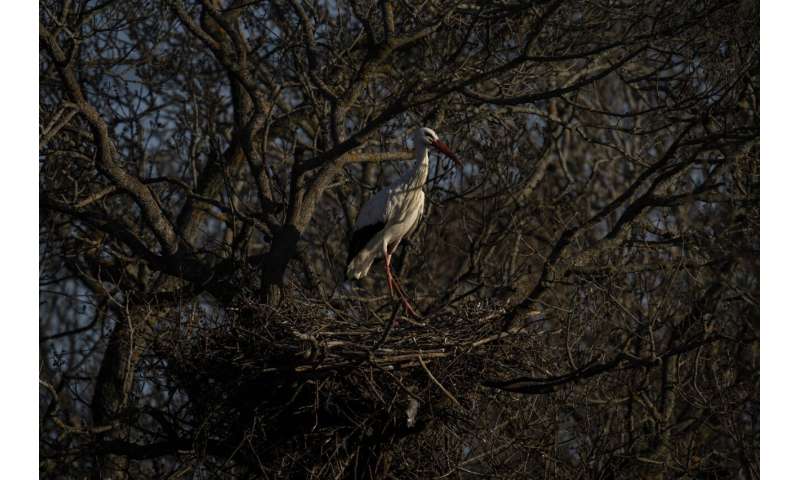
A stork stands on a tree in Soto del Real, on the outskirts of Madrid, Tuesday, Jan. 31, 2023. Europe's storks used to fly south to Africa's Sahel region to spend the winter, stopping off in Spain along the way. But with higher temperatures driven by human-caused climate change and abundant food available at open-air waste disposal sites, most adult storks no longer make the long and exhausting journey. Credit: AP Photo/Bernat Armangue -
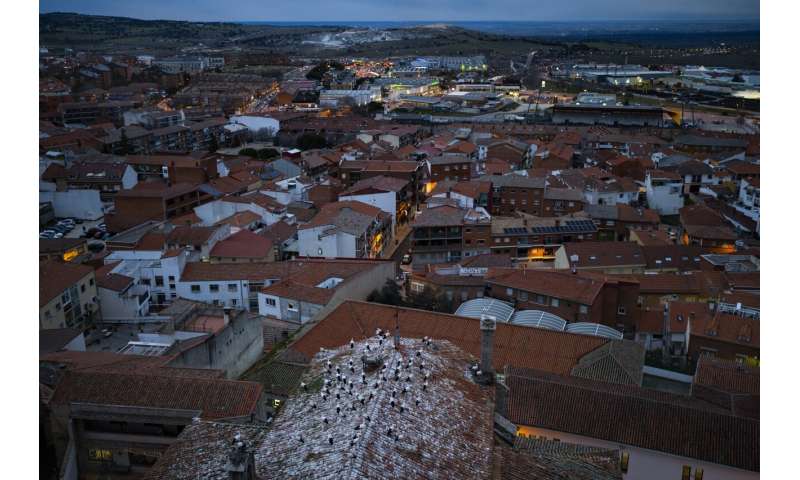
Storks gather atop a basilica during sunset in Colmenar Viejo, on the outskirts of Madrid, Tuesday, Feb. 7, 2023. Europe's storks used to fly south to Africa's Sahel region to spend the winter, stopping off in Spain along the way. But with higher temperatures driven by human-caused climate change and abundant food available at open-air waste disposal sites, most adult storks no longer make the long and exhausting journey. Credit: AP Photo/Bernat Armangue -
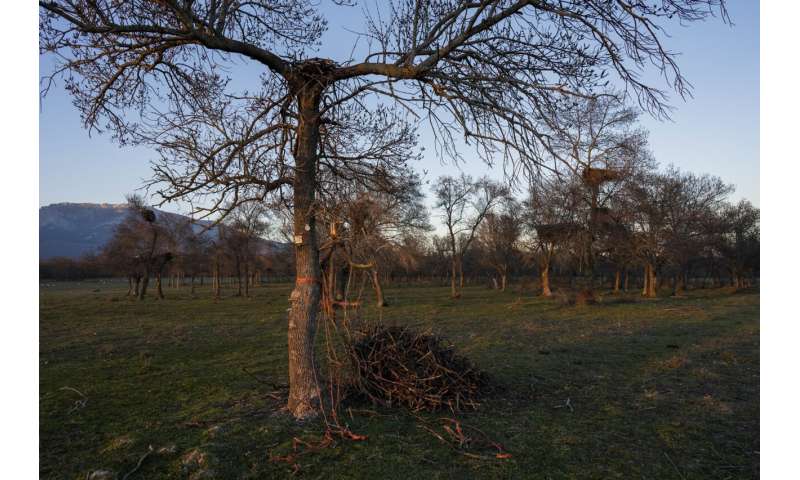
A stork nest lies on the ground after falling from a tree in Soto del Real, on the outskirts of Madrid, Tuesday, Jan. 31, 2023. Europe's storks used to fly south to Africa's Sahel region to spend the winter, stopping off in Spain along the way. But with higher temperatures driven by human-caused climate change and abundant food available at open-air waste disposal sites, most adult storks no longer make the long and exhausting journey. Credit: AP Photo/Bernat Armangue
"This means that the food they are eating right now would cease to exist," López García said, suggesting that an area for storks to feed to be maintained at the garbage dumps. "What we're proposing is that there's a smooth transition that doesn't happen overnight or a closure of landfills."
However, the ultimate benefit of reducing planet-warming methane by cutting organic material in dump sites outweighs the benefit of the food source that the storks can find here, according to López García. "In the medium-to-long term, the feeding from landfills is negative for them," he said.
© 2023 The Associated Press. All rights reserved. This material may not be published, broadcast, rewritten or redistributed without permission.



















